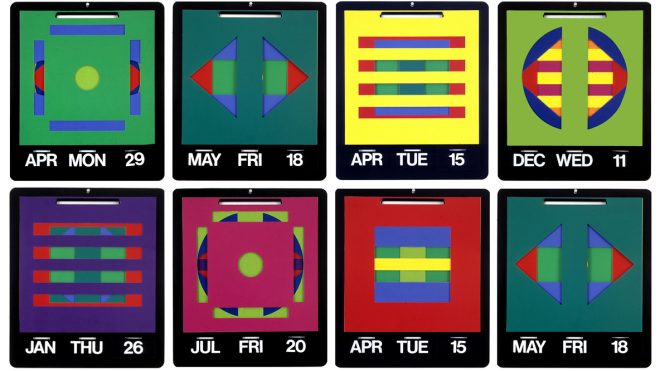Dan Reisinger was born in Kanjiža, Yugoslavia, now Serbia in 1934. Much of his childhood was spent in hiding from the occupying Germans and having lost many family members in the Holocaust, including his father who died in a forced labour battalion of the Hungarian Army, in 1949 he and his mother immigrated to the nascent state of Israel.
Descended from four generations of painters and master-craftsmen, Reisinger soon found work as a housepainter. His sights, however, were set on acquiring a profession in the field of art and design. In 1950, former Bauhaus student Mordechai Ardon, Head of the New Bezalel School of Arts and Crafts, Jerusalem, accepted the eager 16 year-old into the school. Dan’s first poster for the national lottery was published in 1953, and a year later he won the Struck prize for the Bezalel’s most outstanding student.
In 1956, my father, British designer Abram Games, held a course titled Stamp Reproduction for Israel’s Philatelic Services. Twenty-five established designers and students signed up. Reisinger, now in the uniform of the Israel Air Force and head of its publishing division, needed a special pass to leave the base and attend the course. Other students were producing artwork using an airbrush but Dan, who did not have one, skilfully replicated the required effect using only brushstrokes.
Always hard to impress, Abram took an instant liking to the immensely skilled but modest young man and a great friendship and mutual respect flourished between them. In 1960, my father was Dan’s best man at his wedding to Annabelle.
Peace poster, 1968. All images: © Dan Reisinger archive
Poster for Harp contest, 1976
Maccabiah Games poster, 1977
In 1958, Reisinger’s poster for the science pavilion at the Brussels Exposition Universelle won first prize in an international competition. In the same year, seeking new horizons, he arrived in London for further studies in graphic and 3D design at the Central School of Art. Abram introduced him to his professional contacts and to other designers, including George Him and FHK Henrion. Reisinger began to work as a freelancer for the General Post Office and for other British clients. Between 1958 and 1966 he travelled between London and Tel Aviv, where he eventually settled. By now he was gaining an international reputation.
As well as being an educator, he left his brilliant mark all over his adoptive home of Israel. The Games family still gets excited when we spot a ‘dash of Dan’ while travelling through the country. His output was extraordinary. He designed over 150 striking symbols and corporate identities and successfully reworked Otto Treumann and George Him’s 1963 EL AL’s logotype in 1971. He designed all three medals of the Israel Defence Force and seven stamps for the Israel Philatelic Service between 1962 and 1996. He was fascinated by and experimented with Hebrew lettering and calligraphy.
For 60 years, Reisinger’s memorable posters for the Habimah National Theatre, the Maccabiah Games, EL AL, the Israel Defence Force, and much more dominated Israel’s hoardings.
Logotype designs by Dan Reisinger
Poster for EL AL airlines, c. 1970
Poster for a performance of Julius Caesar, 1961
Always conscious of Bauhaus principles, Dan kept his work bold, straightforward and colourful. His three-dimensional and environmental designs were no exception. Israel’s Pavilion at Montreal’s Expo ’67, Tel Aviv’s seaside promenade, Bar Ilan university, medical schools, hospitals, buildings and industrial plants were given the brightly painted Reisinger treatment. His interactive calendars are masterpieces of paper engineering.
Reisinger experienced his life through the three primary colours. Starting life smelling paint and remembering his father holding a paintbrush, he soon learnt how to mix pigments to create the most vibrant spectrum. To him, colour represented a rebirth when he first arrived in Israel. Yellow was the star he was forced to wear in World War II. The liberating Russian Army flew a red flag, and once safe in Israel, the skies were always blue. He said, “Colour, like music, is an emotive value which nourishes the human soul.”
His most moving works however, are for a subject close to his heart and are not in colour. His memorial for the forced labourers of the Hungarian Army during World War II stands defiantly in central Budapest and his 50-metre-long aluminium-cast typographic relief for Holocaust victims is displayed in Jerusalem’s Yad Vashem.
Yad Vashem, 1978
Poster for Israel Museum, 1976
Poster for the Post Office, 1965
Perpetual calendars for MoMA, 1987
Awards have been justly given to Reisinger. In 1998 he received the country’s highest cultural honour – the Israel Prize, “in recognition of his mark on the visual language of the State”. In 2004, the Hungarian Republic honoured him with the Order of the Knight’s Cross, acknowledging his contribution to cultural relations between Hungary and Israel. He has had many one-man shows in Israel, Europe, the Far East and America and his posters are on permanent display in international museums. From their first encounter, my father knew that he was destined to become Israel’s greatest designer.
Always curious and forever young, Dan’s mantra was “turning play into work, and work into play”. He wanted his work to make people smile. When I look at his calendar brightening my kitchen, I always smile and think of him.
Dan Reisinger, 1934-2019; danreisinger.comThe post Dan Reisinger: Master of Colour appeared first on Creative Review.
Dan Reisinger: Master of Colour
By Thomasin Creative News424

